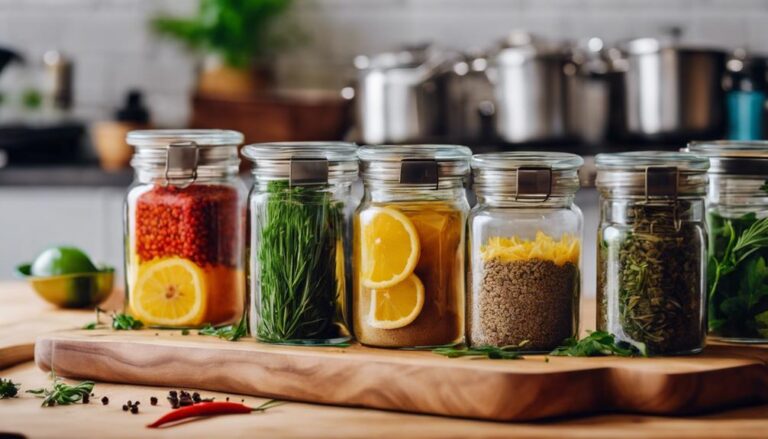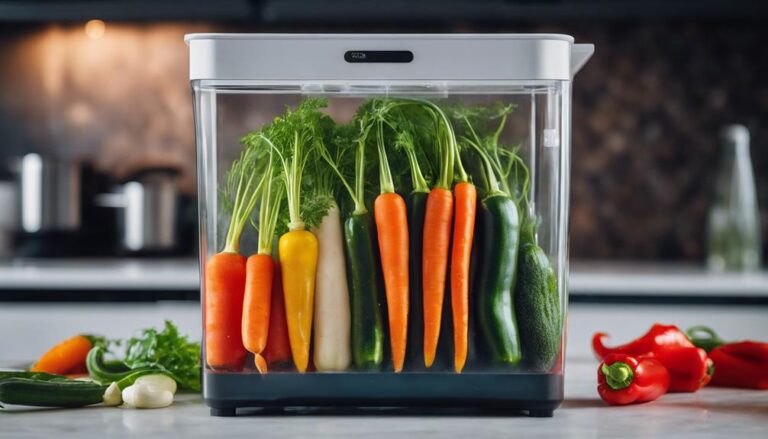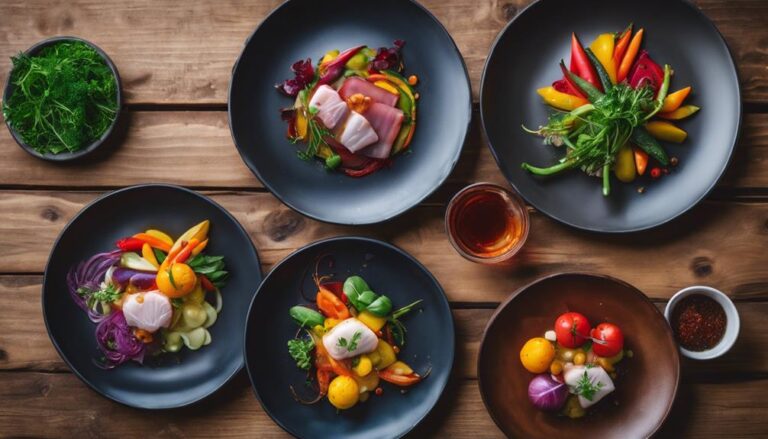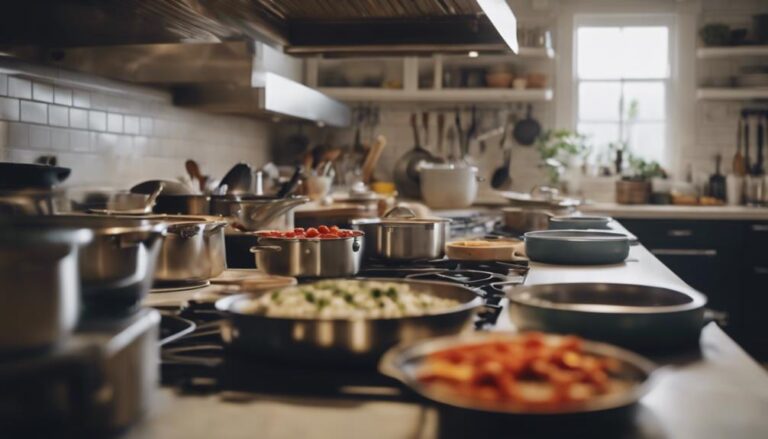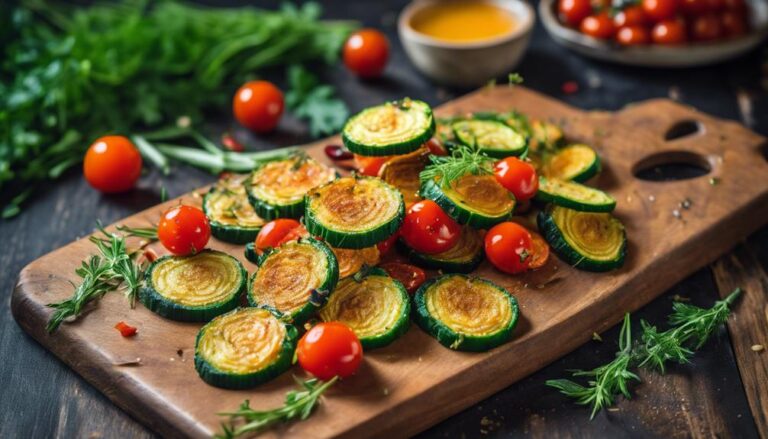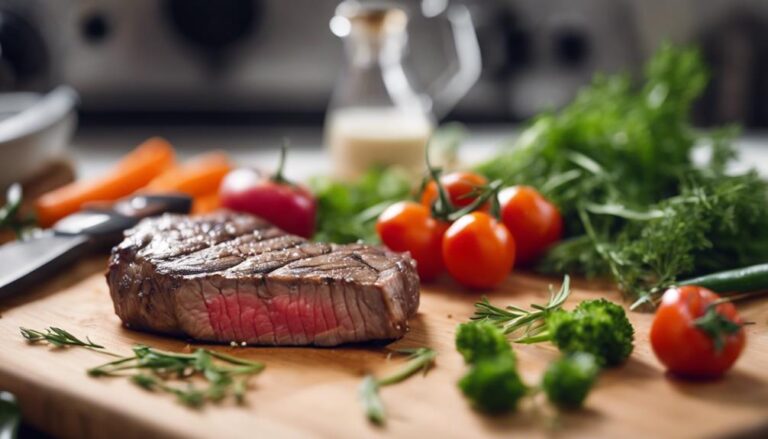Sous Vide Cooking for Clean Eating: A Complete Guide
Sous vide cooking is a fantastic method for clean eating, as it keeps nutrients and flavors intact while preparing meals. I can seal food in vacuum bags and immerse it in water at precise temperatures, typically between 50°C and 60°C. This technique results in tender, juicy dishes that retain their natural goodness. Essential equipment includes an immersion circulator and vacuum seal bags. It's also versatile and suitable for various ingredients, from meats to vegetables. If I want to explore meal prep benefits and discover delicious recipes, there's much more to weigh for a successful clean eating journey.
What You Will Learn Here
- Sous vide cooking retains moisture, nutrients, and flavors, promoting healthier meals ideal for a clean eating lifestyle.
- This method allows precise temperature control, ensuring even cooking and perfect doneness for proteins and vegetables.
- Essential equipment includes an immersion circulator, vacuum seal bags, and heat-safe containers for effective sous vide preparation.
- Incorporating fresh, whole foods and herbs enhances flavor without added fats, aligning with clean eating principles.
What Is Sous Vide Cooking?
Sous vide cooking is a method where I vacuum-seal food in bags and immerse them in water at controlled low temperatures for precise and even cooking. This innovative technique typically involves cooking temperatures ranging from 50 to 60°C (122 to 140°F), allowing for uniform results. By using sous vide cooking, I can retain the food's natural juices and nutrients, which results in healthier meals that boast enhanced flavors and tenderness.
To get started, I need specialized equipment like immersion circulators and vacuum sealers. These tools guarantee proper temperature control and sealing, which are essential for this method.
One of the most appealing aspects of sous vide cooking is its flexibility with cooking times. Depending on what I'm preparing, I can cook food for anywhere from one hour to several days without worrying about overcooking.
This technique not only minimizes cooking risks but also empowers both beginners and experienced chefs to achieve consistent results. As I explore the world of sous vide cooking, I discover new ways to elevate my culinary creations while embracing a clean and flavorful approach to eating.
Benefits of Sous Vide
Exploring sous vide cooking reveals numerous benefits that enhance my culinary experience and promote healthier eating habits.
One of the key advantages is precise temperature control. This guarantees my food cooks evenly and thoroughly, eliminating the risk of overcooking. I appreciate how sous vide retains moisture and natural flavors, resulting in juicier meals with minimal added fats or oils. Plus, the benefits of sous vide extend to nutrient retention; cooking in its own juices preserves essential vitamins and minerals that often get lost in traditional methods.
Another significant benefit is the convenience it offers. I can prepare meals in advance through batch cooking, which is ideal for my busy lifestyle. This method allows me to enjoy healthy, home-cooked meals without spending hours in the kitchen each day.
Additionally, sous vide is accessible to everyone, regardless of skill level. Whether I'm a beginner aiming to improve my cooking or an experienced chef seeking consistent results, I find this technique incredibly rewarding.
Essential Equipment Needed
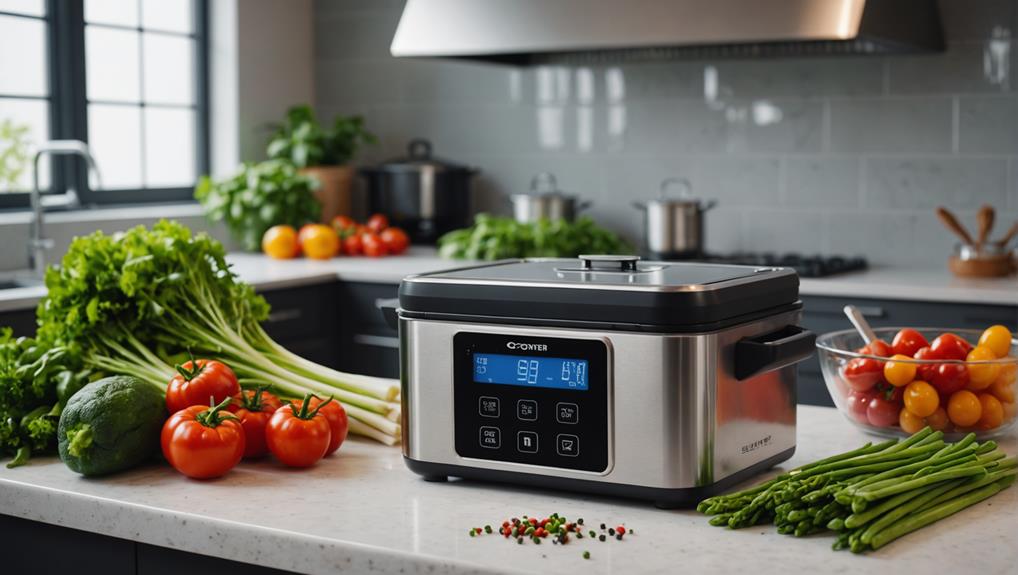
To get started with sous vide cooking, I need a few vital pieces of equipment that guarantee precision and consistency in my meals.
First and foremost, I require an immersion circulator, which regulates the water temperature to make certain my food cooks evenly. A high-quality vacuum sealer is also vital; it removes air from bags, preventing them from floating during cooking and allowing for even heat distribution.
Here's a quick list of essential equipment I consider important for my sous vide journey:
- Immersion circulator: This is the heart of sous vide cooking, maintaining the desired temperature.
- Vacuum seal bags or containers: These guarantee my food is properly sealed for the best cooking results.
Optional accessories, like sous vide weights, can help keep my bags submerged, ensuring consistent cooking results.
Additionally, a digital thermometer may be handy for checking the internal temperature of my food, providing extra accuracy in achieving my desired doneness.
With these essential pieces of equipment, I'm well on my way to mastering sous vide cooking.
Safety Guidelines for Cooking
Maintaining food safety is key when cooking sous vide, as precise temperature control helps prevent bacterial growth and guarantees delicious, safe meals. To achieve this, I make sure to follow essential safety guidelines.
First, I always vacuum seal my food properly to create an airtight environment, minimizing contamination risks during the cooking process.
When cooking meats, I stick to recommended temperatures, usually between 55°C and 60°C, and I pay close attention to cooking times. For instance, chicken breasts require 1 to 4 hours at 65°C, while tougher cuts of beef can benefit from 24 to 48 hours at lower temperatures. It's essential to heat food to a safe minimum internal temperature for the required duration, effectively killing harmful bacteria.
Once I finish cooking sous vide, I quickly chill any leftovers to below 4°C within two hours. This step is critical to prevent bacterial growth during storage.
Recipe Categories
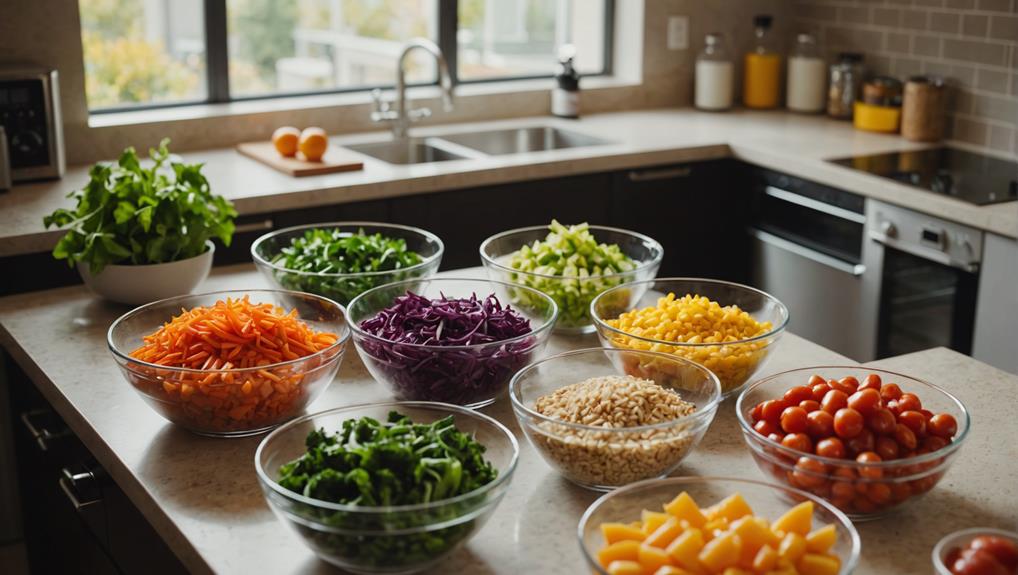
The cookbook features a variety of recipe categories, making it easy for me to find healthy options that suit my clean eating lifestyle. Each category showcases an array of sous vide recipes that transform fresh, whole ingredients into flavorful meals. I appreciate the organization, which caters to different dietary preferences and occasions.
Here are a few recipe categories that stand out:
- Appetizers: Start your meal with light, tasty bites that excite the palate.
- Meats & Seafood: Enjoy tender cuts of meat and perfectly cooked fish, maximizing flavor without sacrificing health.
These categories not only simplify meal planning but also encourage creativity in the kitchen. I love discovering unique recipes like pork burgers and dragon fruit granita, which highlight the versatility of sous vide cooking.
With clear instructions for each dish, I find it easy to experiment, whether I'm a beginner or an experienced cook. This cookbook truly inspires me to embrace a clean eating lifestyle while enjoying delicious, nutritious meals.
Step-by-Step Cooking Process
Vacuum-sealing your food is the first vital step in sous vide cooking, locking in moisture and enhancing flavor throughout the process. I start by placing my ingredients in a vacuum-seal bag, ensuring there are no air pockets, which is essential for ideal results.
Next, I preheat my immersion circulator to the desired cooking temperature, typically between 50°C and 60°C for meats. This temperature range allows for even cooking, ensuring that every bite is tender and juicy.
Once the water bath is ready, I immerse the vacuum-sealed bag, making sure it's fully submerged and not touching the sides or bottom of the container. This helps maintain proper heat circulation. Cooking times vary greatly depending on the type and thickness of the ingredient, with meats often requiring several hours to reach the perfect tenderness I'm aiming for.
After the cooking time is complete, I carefully remove the bag from the water bath. I then open it and finish the dish by searing or broiling, adding that extra layer of texture and flavor.
This step-by-step cooking process is a game-changer in my kitchen, and it's all part of my journey in this Complete Guide to sous vide cooking.
Meal Prep and Planning

Sous vide cooking transforms my meal prep routine, allowing me to prepare healthy, flavorful dishes in advance with precision. By using this technique, I can batch cook meals that retain their nutritional value and delicious taste. The convenience of sous vide means I can plan my meals effectively, saving time during busy weekdays.
Here are three benefits of incorporating sous vide into my meal prep:
- Precision Cooking: I can cook proteins and vegetables to the exact desired doneness, ensuring perfect results every time.
- Batch Cooking: Vacuum-sealing ingredients lets me prepare multiple portions, minimizing spoilage and maximizing flavor.
Planning my sous vide meals allows me to control the ingredients and seasonings used, which aligns perfectly with my clean eating goals.
I often dedicate my weekends to cooking in bulk, portioning meals into containers that I can grab and heat during the week. This innovative approach to meal prep hasn't only streamlined my cooking process but also made healthy eating more accessible and enjoyable.
Tips for Clean Eating
Embracing clean eating means focusing on whole, minimally processed foods that nourish my body and enhance my meals. To cook healthy, I prioritize fresh, organic produce and lean proteins, which align perfectly with clean eating principles. When I use sous vide, the precise temperature control helps me avoid overcooking, ensuring my food retains its natural moisture and rich flavors. This method transforms ordinary ingredients into extraordinary dishes.
I also love the convenience of batch meal prep with sous vide. Preparing healthy, clean meals in advance reduces my reliance on processed foods throughout the week. By incorporating a variety of colorful vegetables and whole grains into my recipes, I create a balanced diet that keeps my meals exciting and nutritious.
To really elevate my clean eating game, I experiment with herbs and spices instead of relying on added fats or preservatives. This not only enhances the flavors but also keeps my meals vibrant and interesting.
With these tips, I can confidently enjoy delicious, clean meals that support my health goals while savoring every bite. Clean eating becomes a delightful journey, especially when sous vide is my cooking method of choice.
Frequently Asked Questions
What Is the Sous Vide Method of Preparing Meals?
The sous vide method captures flavor infusion like no other. I vacuum-seal my food, immerse it in precisely controlled water, and let it cook slowly, resulting in tender, juicy meals bursting with enhanced flavors.
What Principles Are Applied in Sous Vide Cooking to Make It a Safe Cooking Method?
In sous vide cooking, I prioritize food safety by using precise temperature controls, vacuum-sealing to prevent contamination, and following USDA guidelines. This innovative approach guarantees my meals remain delicious and free from harmful bacteria.
What Is Sous Vide Cookbook?
A sous vide cookbook's benefits are incredible! I love how it simplifies cooking with precise instructions and innovative recipes, making it easy to explore new flavors while ensuring healthy, delicious meals that impress everyone.
Is Sous Vide Ready to Eat?
Yes, sous vide meals are ready to eat right after cooking. I love how these ready meals maintain flavor and texture while ensuring safety, transforming my dining experience into something innovative and convenient without extra steps.
Conclusion
To summarize, sous vide cooking offers a versatile method for clean eating that guarantees precise temperature control and enhanced flavors.
By following the essential guidelines and utilizing the right equipment, I can create healthy meals that fit my dietary goals.
The step-by-step process simplifies cooking, making it easy to incorporate into my meal prep routine.
With the variety of recipes available, I can enjoy nutritious dishes that are both satisfying and delicious, all while maintaining a clean eating lifestyle.






